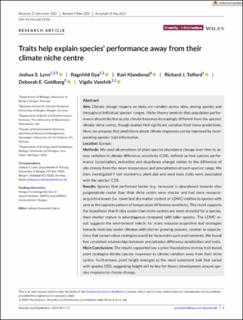| dc.contributor.author | Lynn, Joshua | |
| dc.contributor.author | Gya, Ragnhild | |
| dc.contributor.author | Klanderud, Kari | |
| dc.contributor.author | Telford, Richard James | |
| dc.contributor.author | Goldberg, Deborah E. | |
| dc.contributor.author | Vandvik, Vigdis | |
| dc.date.accessioned | 2023-07-04T08:50:49Z | |
| dc.date.available | 2023-07-04T08:50:49Z | |
| dc.date.created | 2023-06-23T12:44:53Z | |
| dc.date.issued | 2023 | |
| dc.identifier.issn | 1366-9516 | |
| dc.identifier.uri | https://hdl.handle.net/11250/3075487 | |
| dc.description.abstract | Aim: Climate change impacts on biota are variable across sites, among species and throughout individual species' ranges. Niche theory predicts that population performance should decline as site climate becomes increasingly different from the species' climate niche centre, though studies find significant variation from these predictions. Here, we propose that predictions about climate responses can be improved by incorporating species' trait information.
Location: Europe.
Methods: We used observations of plant species abundance change over time to assess variation in climate difference sensitivity (CDS), defined as how species performance (colonization, extinction and abundance change) relates to the difference of site climate from the mean temperature and precipitation of each species' range. We then investigated if leaf economics, plant size and seed mass traits were associated with the species' CDS.
Results: Species that performed better (e.g. increased in abundance) towards sites progressively cooler than their niche centre were shorter and had more resource-acquisitive leaves (i.e. lower leaf dry matter content or LDMC) relative to species with zero or the opposite pattern of temperature difference sensitivity. This result supports the hypothesis that if sites cooler than niche centres are more stressful for a species, then shorter stature is advantageous compared with taller species. The LDMC result suggests the environment selects for more resource-acquisitive leaf strategies towards relatively cooler climates with shorter growing seasons, counter to expectations that conservative strategies would be favoured in such environments. We found few consistent relationships between precipitation difference sensitivities and traits.
Main Conclusions: The results supported key a priori foundations on how trait-based plant strategies dictate species responses to climate variation away from their niche centre. Furthermore, plant height emerged as the most consistent trait that varied with species CDS, suggesting height will be key for theory development around species response to climate change. | en_US |
| dc.language.iso | eng | en_US |
| dc.publisher | Wiley | en_US |
| dc.rights | Navngivelse 4.0 Internasjonal | * |
| dc.rights.uri | http://creativecommons.org/licenses/by/4.0/deed.no | * |
| dc.title | Traits help explain species' performance away from their climate niche centre | en_US |
| dc.type | Journal article | en_US |
| dc.type | Peer reviewed | en_US |
| dc.description.version | publishedVersion | en_US |
| dc.rights.holder | Copyright 2023 the authors | en_US |
| cristin.ispublished | true | |
| cristin.fulltext | original | |
| cristin.qualitycode | 2 | |
| dc.identifier.doi | 10.1111/ddi.13718 | |
| dc.identifier.cristin | 2157457 | |
| dc.source.journal | Diversity and Distributions: A journal of biological invasions and biodiversity | en_US |
| dc.identifier.citation | Diversity and Distributions: A journal of biological invasions and biodiversity. 2023. | en_US |

